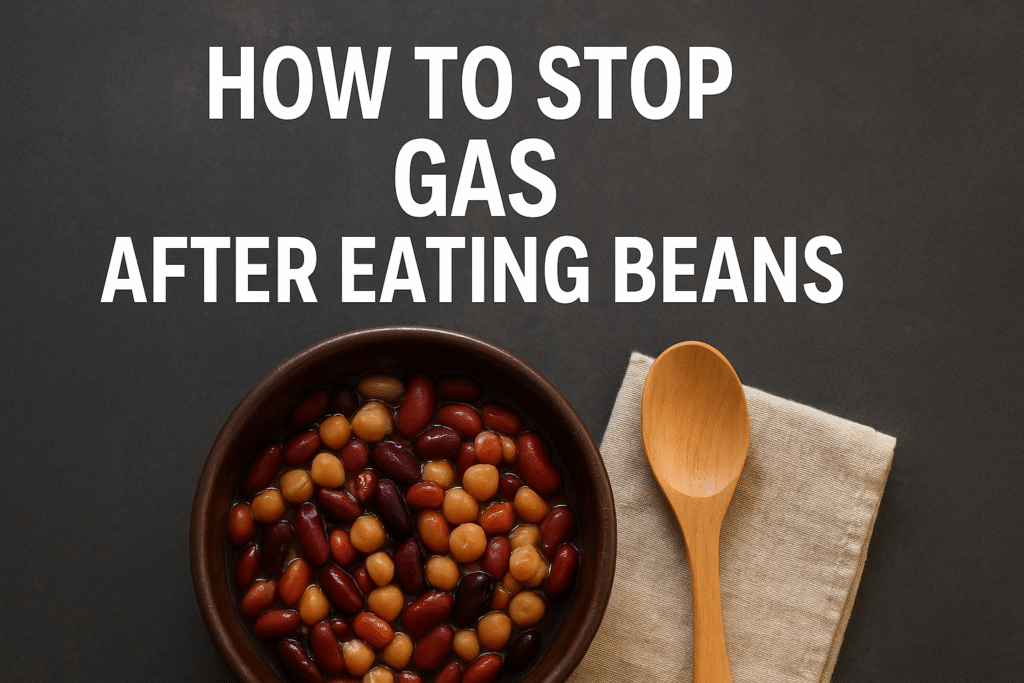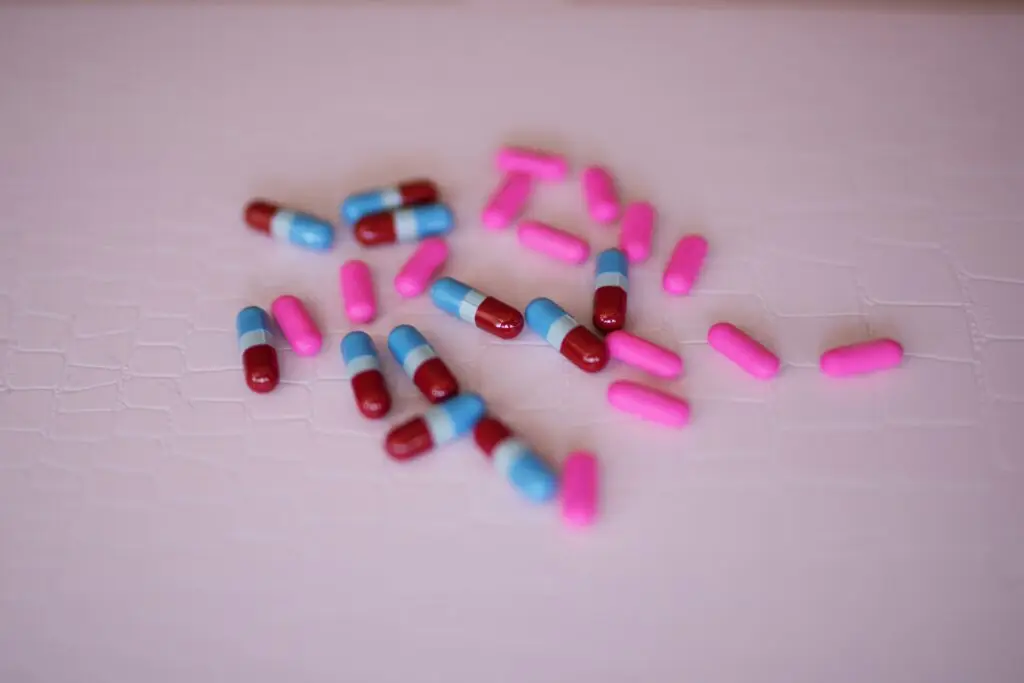
⚠️ Affiliate Disclaimer: This post may contain affiliate links, which means I may earn a small commission — at no extra cost to you — if you make a purchase through one of these links. I only recommend products or services I genuinely trust and believe can provide value. Thank you for supporting My Medical Muse!
How to Stop Gas After Eating Beans: 12 Proven Ways to Prevent Bloating
How to Stop Gas After Eating Beans: 10 Proven Ways to Prevent Bloating and Discomfort
Beans are among the most nutritious foods on the planet. They’re rich in fiber, plant-based protein, and essential minerals that support heart health, balance blood sugar, and promote long-term weight control. For people who follow plant-forward or vegetarian diets, beans are an irreplaceable source of nourishment.
But let’s be honest, for many of us, beans come with an unwelcome side effect, gas and bloating. That post-meal pressure, rumbling, or discomfort can turn a healthy dinner into an awkward experience.
If you love beans but dread the aftermath, you’re far from alone. The good news? Bean-induced gas isn’t inevitable, with a few simple adjustments in how you prepare and eat them, you can enjoy all their benefits without any embarrassment or discomfort afterward.
In this guide, we’ll break down why beans cause gas, what’s really happening inside your digestive system, and the 10 most effective, science-backed ways to stop gas after eating beans for good.
Why Beans Cause Gas
To understand how to prevent gas, it helps to know why beans cause it in the first place.
Beans contain a group of carbohydrates called oligosaccharides, mainly raffinose, stachyose, and verbascose. These sugars are found in all legumes (including lentils, peas, and chickpeas), but beans tend to have higher amounts.
Here’s the catch, your digestive system doesn’t have the right enzyme to break these sugars down. Humans lack α-galactosidase, the enzyme needed to digest oligosaccharides in the small intestine.
So, when you eat beans, these sugars pass through your stomach and small intestine undigested, reaching your large intestine mostly intact. That’s where your gut bacteria step in.
The Science Behind the Gas
Your gut microbiome, the trillions of bacteria living in your intestines ferments the undigested oligosaccharides. This fermentation process produces gases such as hydrogen, methane, and carbon dioxide.
That’s what causes:
- Bloating and abdominal pressure as gas builds up in the intestines
- Flatulence as gas exits the body
- Rumbling or gurgling sounds as your digestive tract tries to move gas along
- Mild cramps or discomfort, especially if gas becomes trapped
This reaction is completely natural and harmless, it’s just your gut bacteria doing their job. However, the amount of gas and discomfort you feel depends on several factors:
- How many beans you eat at once
- How well they were soaked or cooked
- The types of beans (some cause more gas than others)
- Your personal gut bacteria balance and digestive sensitivity.
Here’s the reassuring truth, beans aren’t bad for your digestion. They’re simply rich in fiber and natural plant sugars that your gut bacteria love and sometimes that relationship needs a bit of fine-tuning. Think of it as a partnership, your gut needs time and support to adapt to fiber-rich foods like beans.
By adjusting how you prepare and eat them, you can drastically reduce gas production while still reaping their incredible nutritional benefits.
10 proven ways to stop gas after eating beans
1. Soak Beans Properly Before Cooking
Soaking beans is one of the simplest yet most effective ways to reduce their gas-producing potential. The reason? When beans soak, oligosaccharides, the sugars that cause gas leach out into the water. By discarding this soaking water before cooking, you remove a significant portion of these gas-forming compounds.
How to Soak Beans Correctly:
- Rinse thoroughly: Start by rinsing beans under cold running water to remove dust and debris.
- Soak in plenty of water: Use at least three times as much water as beans. Let them soak overnight (8-12 hours). The beans will expand, so plenty of water ensures they remain fully submerged.
- Add a digestive booster: A teaspoon of baking soda or apple cider vinegar can help soften beans further and break down oligosaccharides.
- Rinse and drain: Before cooking, always rinse beans with fresh water to remove residual sugars.
Quick soak method:
If you’re short on time, bring beans to a rapid boil for 2 minutes, remove from heat, cover, and let them sit for 1 hour. Drain, rinse, and cook as usual.
Studies show that soaking can reduce gas-causing sugars by up to 75%, making it a game-changer for anyone sensitive to beans.
2. Cook Beans Thoroughly
Even well-soaked beans need proper cooking to be fully digestible. Undercooked beans are tougher and contain more resistant starch, which ferments in the gut and produces gas. Fully cooking beans breaks down both oligosaccharides and starch, making them gentler on your digestive system.
Cooking Tips for Gas-Free Beans:
- Simmer slowly: Boiling aggressively can split the skins and leave the centers undercooked. Bring beans to a boil, then reduce heat and simmer gently until soft.
- Use a pressure cooker: Pressure cooking shortens cooking time and significantly reduces gas-producing compounds. Your beans will be creamy, tender, and easier on your stomach.
- Add digestive spices during cooking: Traditional spices like ginger, cumin, bay leaves, or asafoetida (hing) not only add flavor but also aid digestion. Asafoetida, in particular, contains natural enzymes that help break down complex sugars.
Fully cooked beans are easier to chew, digest, and absorb, they significantly reduce post-meal bloating.
3. Use Gas-Reducing Herbs and Spices
For centuries, cultures around the world have paired beans with digestive-friendly herbs and spices to prevent flatulence. These ingredients not only enhance flavor but also support your digestive system by stimulating enzyme activity and calming the gut.
Top Herbs and Spices to Add:
- Cumin: Promotes enzyme activity and reduces bloating.
- Ginger: Stimulates digestive motility and soothes the stomach lining.
- Turmeric: Has anti-inflammatory properties that can reduce gas and irritation.
- Peppermint: Relaxes gut muscles and helps release trapped gas.
- Coriander and fennel seeds: Traditional carminatives known to prevent bloating.
Combine 2-3 of these spices in soups, stews, or bean salads for the best results. Not only will your dishes taste amazing, but your gut will thank you too.
4. Introduce Beans Gradually
Even perfectly soaked and cooked beans can cause discomfort if your digestive system isn’t used to them. A sudden large serving can overwhelm your gut bacteria, leading to more fermentation and gas.
How to Build Tolerance:
- Start with 2-3 tablespoons per day.
- Gradually increase your intake over 2-3 weeks.
- Pay attention to how your body reacts and adjust portions accordingly.
Over time, your gut microbiome adapts to fermenting oligosaccharides efficiently. This gradual introduction not only prevents gas but also maximizes the nutritional benefits of beans.
5. Combine Beans with Digestive-Friendly Foods
Pairing beans with the right foods can make them easier to digest and further reduce gas formation. Certain combinations help balance digestion and provide additional nutrients.
Smart Pairings Include:
- Beans and rice or quinoa: Combines plant proteins to create a complete amino acid profile and promotes smoother digestion.
- Beans and vegetables (spinach, kale, carrots): Adds fiber diversity and digestive enzymes, reducing fermentation-related gas.
- Avoid heavy fats or dairy: High-fat meals or dairy-heavy dishes slow digestion, increasing the chance of gas and bloating.
Adding a splash of apple cider vinegar or lemon juice at the end of cooking increases acidity and helps your digestive enzymes break down beans more effectively.
6. Drink Enough Water
Proper hydration is essential for digesting beans smoothly. Beans are packed with both soluble and insoluble fiber, which absorb water as they move through your digestive tract. If you’re dehydrated, fiber can slow down digestion, ferment excessively, and cause bloating and gas.
Hydration Tips for Bean Lovers:
- Drink water throughout the day, not just during meals, to keep fiber moving efficiently.
- Avoid carbonated beverages during or immediately after meals, as the bubbles add extra gas.
- Sip herbal teas like peppermint, ginger, or chamomile, which can relax the digestive tract and relieve bloating naturally.
- Warm water after meals can gently stimulate digestion, helping your intestines move gas along.
Staying properly hydrated ensures that the fiber in beans travels smoothly through your gut, reducing pressure buildup and minimizing discomfort.
7. Try Digestive Enzyme Supplements
Even with careful cooking and gradual introduction, some people still experience persistent gas. That’s where enzyme supplements come in handy.
Products like Beano contain α-galactosidase, the enzyme your body naturally lacks to break down oligosaccharides. This allows your digestive system to process beans more efficiently, preventing excessive gas production.
How to Use Digestive Enzymes:
- Take the supplement before or with your first bite of beans.
- They are most effective with moderate servings of beans, such as a cup or less.
- Studies show that α-galactosidase can reduce intestinal gas by up to 70% in sensitive individuals.
While supplements aren’t mandatory, they’re a practical tool for social situations or for those who enjoy larger portions of beans.
8. Eat Slowly and Mindfully
How you eat can be just as important as what you eat. Eating too quickly causes you to swallow excess air, a phenomenon called aerophagia,which adds to gas and bloating. Rushing meals also prevents your body from properly signaling fullness, leading to overeating and additional digestive strain.
Mindful Eating Tips:
- Take smaller bites and chew thoroughly to help enzymes in your saliva begin breaking down food.
- Put your fork down between bites to slow your pace naturally.
- Avoid talking while chewing, which reduces swallowed air.
- Focus on savoring each bite, improving digestion and enhancing nutrient absorption.
Chewing well reduces the digestive workload on your intestines, minimizes fermentation in the large intestine, and helps prevent uncomfortable gas.
9. Move Your Body After Meals
Gentle physical activity after eating is a surprisingly effective way to relieve gas. Sitting or lying down immediately after a bean-heavy meal can trap gas in your intestines, causing bloating and discomfort.
Effective Post-Meal Activities:
- Take a 10-15 minute walk: it stimulates digestive motility and helps gas move through the intestines.
- Try gentle yoga poses like the wind-relieving pose (Pawanmuktasana), cat-cow, or child’s pose, which help release trapped gas.
- Avoid intense workouts immediately after eating; wait at least 30 minutes to prevent digestive distress.
Regular movement not only encourages the passage of gas but also promotes overall digestive health and prevents painful buildup.
10. Keep Track and Identify Triggers
Everyone’s digestive system reacts differently to beans. While one person can eat lentils without issue, another may feel bloated after chickpeas. Tracking your reactions helps you identify patterns and optimize your bean consumption.
How to Keep a Bean Diary:
- Record the type of beans eaten (black beans, kidney, lentils, chickpeas).
- Note how they were prepared, soaked, canned, pressure-cooked, etc.
- Track the timing and severity of symptoms, including bloating, gas, or cramping.
By analyzing your diary:
- You may discover that lentils produce less gas than kidney beans.
- Canned beans (if rinsed thoroughly) are often easier to digest than dried beans.
- Smaller servings may be well-tolerated, while large portions trigger discomfort.
Over time, you’ll learn which beans and cooking methods work best for your body, allowing you to enjoy them without fear of bloating or gas.
11. Best Beans for Less Gas
Not all beans are created equal when it comes to digestive comfort. Some beans naturally produce less gas due to lower oligosaccharide content or softer textures.
Here’s a quick ranking from easiest to hardest to digest:
- Lentils (especially red or yellow)
- Split peas
- Black-eyed peas
- Mung beans
- Black beans
- Navy beans
- Kidney beans
- Soybeans
If you’re new to beans, start with lentils or mung beans. They’re softer, cook faster, and are less likely to cause bloating. Gradually, you can experiment with harder-to-digest varieties.
12. Use Kombu or Seaweed
Adding a strip of kombu (a type of edible seaweed) during cooking is a traditional trick that can drastically reduce gas.
- How it works: Kombu contains natural enzymes that help break down raffinose and stachyose, the oligosaccharides that cause gas during cooking.
- Extra benefits: Kombu also enriches your beans with trace minerals like iodine and magnesium.
- Usage: Add a strip of kombu to your cooking water, then remove before serving. The result is softer, more digestible, and more nutritious beans.
The Health Benefits of Beans (Don’t Miss Out!)
It’s easy to focus on the gas and forget why beans are such a superfood. Here’s why you should make them a regular part of your diet:
- High fiber: Supports gut health, lowers cholesterol, and stabilizes blood sugar.
- Plant-based protein: An excellent source of protein for vegetarians and vegans.
- Micronutrients: Rich in folate, magnesium, potassium, and iron.
- Longevity connection: Populations in Blue Zones regions where people live the longest, eat beans daily.
Remember, Gas is simply your gut microbes adjusting to healthy fiber intake. It’s not a reason to give up beans.
Common Myths About Bean Gas
Bean-related gas is often misunderstood, and many myths prevent people from enjoying this nutritious food. Let’s set the record straight:
Myth 1: Gas from beans means you’re intolerant
- Fact: Experiencing gas after eating beans is completely normal. It’s simply your gut bacteria fermenting the oligosaccharides in beans. Most people’s digestive systems adapt over time, producing less gas as your microbiome becomes more efficient.
Myth 2: Canned beans always cause more gas
- Fact: Rinsed canned beans can actually cause less gas than dried beans. The canning process removes a portion of oligosaccharides into the liquid, and rinsing them further reduces these sugars. Proper preparation often makes canned beans easier on the digestive system.
Myth 3: Taking antacids helps
- Fact: Antacids target stomach acid, not intestinal gas. They are ineffective for reducing bean-related bloating or flatulence. For best results, use digestive enzymes like α-galactosidase, which break down the gas-causing sugars directly in the digestive tract.
When to See a Doctor
Most cases of gas after eating beans are completely normal and harmless. However, if you notice severe or persistent symptoms, it’s important to consult a healthcare professional.
Signs You Should Seek Medical Advice:
- Severe abdominal pain or cramping that doesn’t improve after passing gas or a bowel movement.
- Persistent diarrhea that lasts more than a few days or occurs frequently after meals.
- Ongoing bloating or discomfort even after using the strategies outlined in this guide.
Possible Underlying Conditions:
A doctor or registered dietitian can help determine whether your symptoms are due to:
- Irritable Bowel Syndrome (IBS): A condition that affects gut motility and sensitivity.
- Small Intestinal Bacterial Overgrowth (SIBO): Excess bacteria in the small intestine can worsen gas and bloating.
- Food intolerances, including sensitivities to high-FODMAP foods, which include many types of beans.
How a Professional Can Help:
A gastroenterologist or registered dietitian can:
- Identify specific triggers and foods that cause discomfort.
- Suggest dietary adjustments or elimination plans.
- Recommend safe portion sizes and preparation methods to help you enjoy beans without pain.
By getting personalized guidance, you can continue reaping the health benefits of beans while keeping gas and bloating under control.
Final Thoughts
Learning how to stop gas after eating beans is all about balance, preparation, and gradual adaptation. Beans are incredibly nutritious, but their high fiber and complex sugars can take your digestive system a little time to adjust. By adopting the right habits, you can turn beans from a potential source of discomfort into a digestive-friendly nutritional powerhouse.
Key Steps to Make Beans Gentle on Your Gut:
- Start slowly: Introduce beans in small portions and gradually increase serving sizes. This gives your gut microbiome time to adapt.
- Use science-backed techniques: Soak beans overnight, cook them thoroughly, and consider enzyme supplements like α-galactosidase for stubborn cases.
- Pair wisely: Combine beans with digestive-friendly foods, spices, or herbs to improve tolerance and reduce gas.
- Hydrate and move: Drink water throughout the day and engage in light movement after meals to help gas pass smoothly.
- Listen to your body: Everyone’s digestive system is unique. Pay attention to which beans and preparation methods work best for you.
With patience and these practical strategies, you’ll soon be able to enjoy chili, lentil soup, bean salads, or any bean-based dish without discomfort, bloating, or embarrassment, just the nourishing benefits that make beans a staple of a healthy diet.
👩⚕️ Need Personalized Health Advice?
Get expert guidance tailored to your unique health concerns through MuseCare Consult. Our licensed doctors are here to help you understand your symptoms, medications, and lab results—confidentially and affordably.
👉 Book a MuseCare Consult NowRelated Blog Post You Might Like:
- Why Do I Crave Peanut Butter Late at Night? 7 Shocking Reasons Explained
- Why Do I Feel Full but Still Hungry? 11 Powerful Reasons Explained
- Why Do I Gain Weight When I Don’t Sleep Enough? 11 Proven Scientific Reasons You Can’t Ignore
- Why Does My Face Gain Weight Before My Body: 7 Surprising Reasons
- 7 Surprising Reasons for Weight Gain After Quitting Sugar (and How to Fix It Fast)
- 7 Surprising Reasons Why You Gain Weight After Stopping Exercise
- 7 Hidden Reasons Why You Get Constipated After Eating Rice (and What Really Helps)
- Why Does Salad Make My Stomach Hurt? 10 Powerful Everyday Fixes That Work


